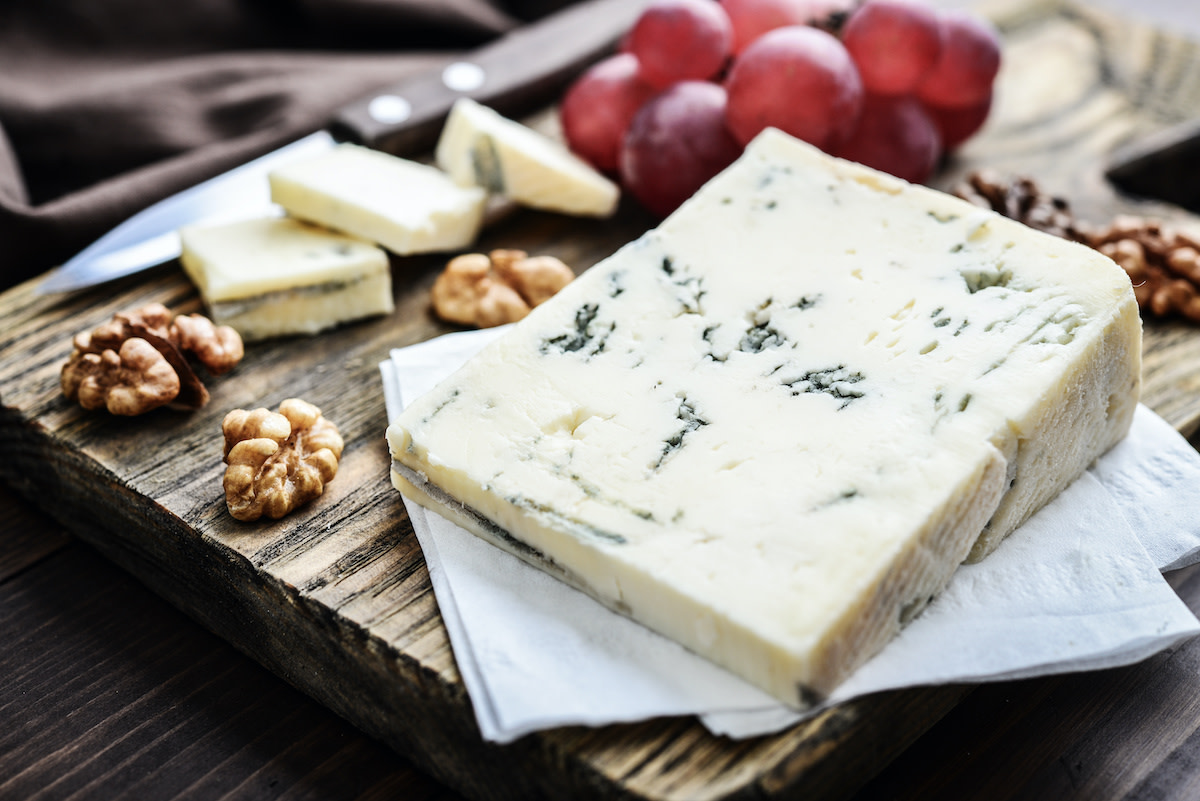Guide to Gorgonzola: 3 Ways to Enjoy Gorgonzola Cheese
Written by MasterClass
Last updated: Jul 14, 2021 • 3 min read
Gorgonzola cheese is a white cheese with unique blue marbling throughout. This cheese commonly appears in Italian dishes, nodding to its northern Italian origins.
Learn From the Best
What Is Gorgonzola?
Gorgonzola is an Italian cheese traditionally made from pasteurized cow’s milk and has the signature blue veins you find in blue cheese. The cheese can also be made with unskimmed goat’s milk or sheep’s milk, but those are less common. It has a firm and crumbly texture with a fat content usually between 25 and 35 percent. This cow’s milk cheese is traditionally produced in the northern Italian areas of Piedmont and Lombardy, including a town in the Lombardy region called Gorgonzola.
The marbling you see on the inside is thanks to Penicillium roqueforti, a mold cheese makers use to age cheese. They also use Penicillium glaucum, but the roqueforti variety is much more common.
In order for cheese to be called Gorgonzola, it must be awarded the DOP, or Denominazione di Origine Protetta (Protected Designation of Origin). If you find a cheese labeled Gorgonzola that doesn’t have the DOP stamp, it’s not really Gorgonzola.
How Gorgonzola Is Made
The process of making gorgonzola takes about three to four months and is as follows:
- Curdle the milk. Once you have your pasteurized cow’s milk, add certain yeasts and rennet (which help to break solids away from water in the milk—also known as separating the curds and whey) to aid in the coagulation and curdling process.
- Add some heat. The marbling effect has been triggered by the yeast and rennet, and now the milk will be set to curdle while being gently heated to a specific temperature, usually around 86–90°F.
- Cut the curds. Next, cut the curd into cubes and set aside the drained-away whey to discard it or use it in other areas of cooking.
- Prepare for aging. Place the curds in molds, which are then coated and brined in sea salt to help create a rind.
- Encourage the blue veins. Now that the cheese is in the mold, prick the rind with a metal skewer to ensure the marbling will appear throughout the final product.
- Age the cheese. After a minimum of 50 days of aging, the Italian cheese can be certified as Gorgonzola and enjoyed.
Types of Gorgonzola Cheese
Gorgonzola is a blue cheese, but not all blue cheeses are Gorgonzola. In order to legally be called Gorgonzola, the cheese must be produced in either the Piedmont or Lombardy region of Italy, including the provinces inside of those regions, like Milan, Novara, and Como, just to name a few.
There are only two varieties of Gorgonzola: Gorgonzola dolce and Gorgonzola piccante. The dolce is the less aged of the two varieties and is also called sweet Gorgonzola, as the shorter aging process produces a sweeter cheese, at least compared to the more aged variety. The piccante is the more aged of the two Gorgonzola cheeses and is also referred to as Gorgonzola Naturale, Gorgonzola Montagna, or Mountain Gorgonzola.
4 Cheeses Often Confused for Gorgonzola
There are popular cheeses that are not Gorgonzola but instead are blue cheeses. Here are a few that are sometimes mistaken for Gorgonzola:
- 1. Cabrales: Spain produces this blue cheese that is semihard and very strong in flavor.
- 2. Danish blue: Denmark makes this super creamy blue cheese.
- 3. Roquefort: Cheese makers use the same mold—Penicillium roqueforti—to craft Roquefort that they use to make Gorgonzola, but Roquefort cheese is a blue cheese from France, with no rind, a good crumble, and a very tangy taste.
- 4. Stilton: Stilton originates in England and is on the softer side, yet still crumbly.
3 Ways to Enjoy Gorgonzola
Italians have produced Gorgonzola cheese since the late 800s AD, so it makes sense that Gorgonzola complements Italian dishes well. Here are some ways to enjoy this blue mold cheese:
- In sweet dishes: Both Gorgonzola dolce and Gorgonzola piccante pair well with honey, dried fruit, and sweeter vinaigrettes on salads.
- In savory dishes: Savory dishes are probably what people think of the most when they think of any blue cheese, especially Gorgonzola. Salad, pasta, polenta, and risotto are excellent ways to showcase Gorgonzola cheese.
- In sauces: Gorgonzola mixes well with other types of creamy dairy to make a sauce. Try mixing it with mascarpone cheese, heavy cream, and even a little Parmesan cheese for a rich sauce perfect for pouring over a piece of filet mignon. If you’re using the Gorgonzola dolce, mix in a type of swiss cheese, like Gruyere, for a saltier, sharper bite.
Want to Learn More About Cooking?
Become a better chef with the MasterClass Annual Membership. Gain access to exclusive video lessons taught by the world’s best, including Alice Waters, Gabriela Cámara, Niki Nakayama, Chef Thomas Keller, Gordon Ramsay, Yotam Ottolenghi, Dominique Ansel, and more.
